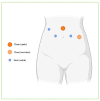New clinical insights into the treatment of benign uretero-ileal anastomotic stricture following radical cystectomy and urinary diversion
- PMID: 39267462
- PMCID: PMC11393432
- DOI: 10.1002/cam4.70229
New clinical insights into the treatment of benign uretero-ileal anastomotic stricture following radical cystectomy and urinary diversion
Abstract
Background: Benign uretero-ileal anastomotic stricture (UIAS) is a potentially serious complication that can arise after radical cystectomy (RC) and subsequent urinary diversion. To preserve residual renal function and improve prognosis, it is crucial to derive insights from experience and tailor individualized treatment strategies for different patients.
Patients and methods: From October 2014 to June 2021, a total of 47 patients with benign UIAS underwent endoscopic management (n = 19) or reimplantation surgery (n = 28). The basic data, perioperative conditions, and postoperative outcomes of the two groups were compared and analyzed to evaluate efficacy.
Results: Comparing preoperative and postoperative clinical efficacy within the same group, the endoscopic group showed no significant differences in creatinine and blood urea nitrogen (BUN) levels before surgery or after extubation (p > 0.05). However, significant differences were observed in glomerular filtration rate (GFR) levels on the affected side before surgery and after extubation (p < 0.05). In contrast, the laparoscopic reimplantation group did not exhibit significant differences in creatinine, BUN, or GFR levels of affected side before surgery and after extubation (p > 0.05). Postoperative clinical efficacy showed no significant difference in creatinine and BUN levels between the two groups (p > 0.05). However, GFR values of affected side in the endoscopic treatment group decreased more than those in the laparoscopic reimplantation group (p < 0.05). Additionally, the laparoscopic reimplantation group was able to remove the single-J tube earlier than the endoscopic treatment group (p < 0.05), had a lower recurrence rate of hydronephrosis after extubation (p < 0.05), and experienced a later onset of hydronephrosis compared to the endoscopic treatment group (p < 0.05).
Conclusions: Based on our experience in treating UIAS following RC combined with urinary diversion, laparoscopic reimplantation effectively addresses the issue of UIAS, allowing for the removal of the ureteral stent relatively soon after surgery. This approach maintains long-term ureteral patency, preserves residual renal function, reduces the risk of ureteral restenosis and hydronephrosis, and has demonstrated superior therapeutic outcomes in this study.
Keywords: benign uretero‐ileal anastomotic stricture; bladder cancer; endoscopic treatment; radical cystectomy; robotic and laparoscopic ureteral reimplantation.
© 2024 The Author(s). Cancer Medicine published by John Wiley & Sons Ltd.
Conflict of interest statement
The authors declare no conflict of interest.
Figures


Similar articles
-
Treatment of ureteral anastomotic strictures with reimplantation and survival after cystectomy and urinary diversion.Urol Oncol. 2017 Jan;35(1):33.e1-33.e9. doi: 10.1016/j.urolonc.2016.07.018. Epub 2016 Aug 29. Urol Oncol. 2017. PMID: 27595462
-
A multicenter study of perioperative and functional outcomes of open vs. robot assisted uretero-enteric reimplantation after radical cystectomy.World J Urol. 2025 Jan 16;43(1):74. doi: 10.1007/s00345-024-05435-x. World J Urol. 2025. PMID: 39820547
-
[Initial clinical experience and follow-up outcomes of treatment for ureteroileal anastomotic stricture with Allium coated metal ureteral stent].Beijing Da Xue Xue Bao Yi Xue Ban. 2020 Aug 18;52(4):637-641. doi: 10.19723/j.issn.1671-167X.2020.04.007. Beijing Da Xue Xue Bao Yi Xue Ban. 2020. PMID: 32773792 Free PMC article. Chinese.
-
Internal double-J stent was associated with a lower incidence of ureteroileal anastomosis stricture than external ureteral catheter for patients undergoing radical cystectomy and orthotopic neobladder: A systematic review and meta-analysis.Int J Surg. 2019 Dec;72:80-84. doi: 10.1016/j.ijsu.2019.10.023. Epub 2019 Nov 1. Int J Surg. 2019. PMID: 31683041
-
Unraveling the Complexities of Uretero-Enteric Strictures: A Modern Review.Curr Urol Rep. 2024 Nov;25(11):287-297. doi: 10.1007/s11934-024-01222-8. Epub 2024 Aug 14. Curr Urol Rep. 2024. PMID: 39138815 Review.
Cited by
-
Robot-assisted radical cystectomy with the clinical application of "Y-shaped" end-to-side ureteral anastomosis in elderly and obese patients.BMC Urol. 2025 Mar 20;25(1):56. doi: 10.1186/s12894-024-01684-5. BMC Urol. 2025. PMID: 40114107 Free PMC article.
References
-
- D"Agostino D, Racioppi M, Pugliese D, et al. Postoperative quality of life in patients with Ileal Neobladder at short‐, intermediate‐ and long‐term follow‐up. Urol Int. 2016;97(1):54‐60. - PubMed
-
- Lee RK, Abol‐Enein H, Artibani W, et al. Urinary diversion after radical cystectomy for bladder cancer: options, patient selection, and outcomes. BJU Int. 2014;113(1):11‐23. - PubMed
-
- Madersbacher S, Schmidt J, Eberle JM, et al. Long‐term outcome of ileal conduit diversion. J Urol. 2003;169(3):985‐990. - PubMed
MeSH terms
Substances
Grants and funding
LinkOut - more resources
Full Text Sources
Medical

